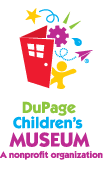At DuPage Children’s Museum, we continue to observe how exhibits are used even after the prototyping stage. Many museums use an evaluation system, with front-end (gathering information about what visitors know prior to developing an exhibit), formative (field-testing your exhibit or activity during development), and summative (finding out what visitors are actually getting out of it when the exhibit is on display) evaluation. Additionally, you can conduct remedial evaluation, where you are conducting summative evaluation with an eye to making change, if necessary. Our remedial evaluation program is conducted through a series of observations by our Early Childhood Specialist, and discussed with the exhibit development team.
One recent example of this exhibit remediation occurred with our Color Booth. This exhibit is a 3-sided, white laminate booth with a mirror inside. There is also a low shelf for colorful manipulative pieces and/or photos, and a color-change technology called “cycling color burst.” The main idea of the original developer of this exhibit was that young children learn through their senses and are most interested in themselves, and are actively engaged in looking at and understanding color in their life.
The exhibit was arranged so that the light, as it changed, affected the colors of the objects on the shelf and the colors of your clothes as you stood in the booth. You may have seen similar color booths around the country in science centers, but these tend to have one single color that creates a single dramatic effect. Their text and design are also often aimed at older children and adults. The idea here at DCM was to enable children to experience the effect of different colored light on themselves and their surroundings. We have been working with this for a while, and have found some interesting things. More on this in future blogs.
skip to main |
skip to sidebar

Facebook Badge
About DuPage Children's Museum
- DuPage Children's MUSEUM
- DuPage Children's Museum is a private, non-profit 501(c)(3) organization in Naperville, Illinois located 30 miles outside of Chicago.
Support DuPage Children's Museum
Subscribe to the DCM Blog via Email
_______________________________
DCM on You Tube
______________________________
The DCM Blog, How Learning Comes in to Play! is generously funded by:
________________________________
Useful Links
_______________________________
Categories of Previous Posts
_______________________________
Blog Archive
______________________________
Printable DCM Focus Topic Resources:
Top 5 Play to Learn Blog Posts
Contact Us:
Copyright, 2008 - DuPage Children's Museum







